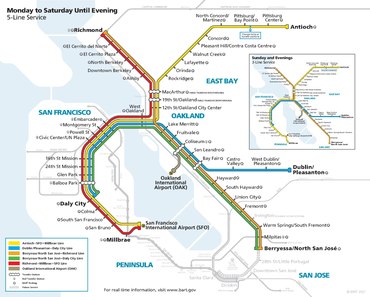Bay Area Rapid Transit expansion
The initial 1962 BART maps approved by voters included several lines beyond the core system marked as Possible Future Extensions.
[1] Some have since come to fruition as previous extensions of the system:[2] An additional corridor not part of the 1962 plan completed since the agency's inception is the automated guideway transit spur line that connects BART to Oakland International Airport which opened in 2014.
However, in February 2009, projections of lower-than-expected sales-tax receipts from the funding measures forced the Santa Clara Valley Transportation Authority to scale back the extension, ending it at the Berryessa/North San José station and delaying tunneling under downtown San Jose to a future phase of construction (making it essentially a "Phase 2" of the project).
Separate construction plans by San Jose International Airport would bring a people-mover train to either the Santa Clara Depot or to Diridon Station.
[7] For the subway segment in San Jose, VTA plans to use a tunnel boring machine for most of the length in order to reduce disruptions to downtown during construction.
VTA allocated initial funds for constructing BART using the proceeds from a sales tax referendum which was passed by Santa Clara County voters in 2000.
[14] In 2004, the Federal Transit Administration decided to wait to fund the project, citing worries that BART did not have enough money to operate the extension.
[17] Projections by an independent consultant recommended by the Federal Transit Administration predicted that the 1⁄8-cent sales tax would more than cover operation and maintenance of the proposed extension.
[25] It could possibly continue over the Altamont Pass into Tracy and the Central Valley along I-580 and/or go north through Dublin, San Ramon, Danville, and Alamo to the existing Walnut Creek station via the I-680 corridor.
[citation needed] In 2017, citing lack of interest in the project from BART, the Livermore City Council proposed a newly established local entity to undertake planning and construction of the extension,[35] which was also recommended by the California State Assembly Transportation Committee.
This would emerge at the Salesforce Transit Center to provide connecting service to Caltrain and the planned California High-Speed Rail (CAHSR) system.
[46] Part of the plan for the original system before Marin County's departure from the BART District was a line running under Geary Street and turning north to the Golden Gate Bridge.
In 1995, the San Francisco Municipal Railway hired Merrill & Associates to study the possibility of building a new BART subway beneath Geary in conjunction with adding light rail on the surface.
These plans were dropped, according to former Senator Quentin L. Kopp, due to merchant and resident opposition, citing potential blight similar to that caused by Market Street Subway construction two decades earlier.
[51] The extension to Hercules is controversial in that the main proponent wants to build it directly from the El Cerrito del Norte BART station while the city of Richmond is very opposed to this.
[39] In 1999, a short-lived proposal to extend BART from the Millbrae station (then under construction) to Menlo Park was advanced by the San Mateo County Economic Development Association (SAMCEDA).
The Doolittle Maintenance and Storage Facility, initially slated to be opened as a full station along the Oakland Airport Connector, may be repurposed for passenger service at a later date.
[59][60] A proposal for a Jack London Square station in Oakland was rejected in 2004 as being incompatible with existing track geometry; a one-station stub line at the foot of Broadway and the use of other transit modes also were studied.


